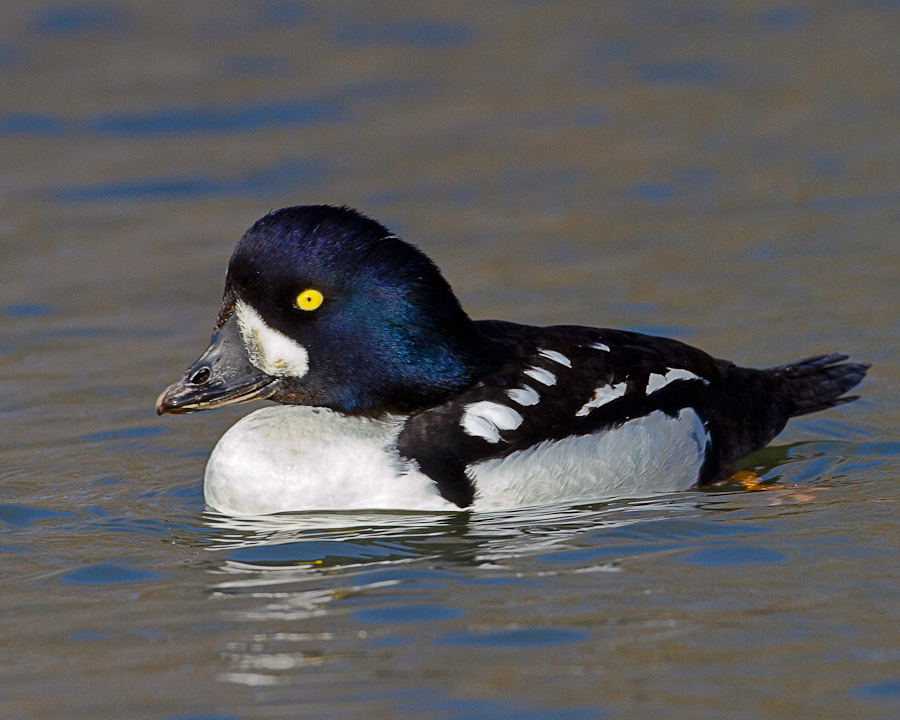
Barrow's goldeneye(Bucephala islandica)
Phylum —chordata
Class — aves
Order — anseriformes
Family — anatidae
Genus –bucephala
Appearance
Adults are similar in appearance to the common goldeneye. On average, adult males are 19.2 in (49 cm) long and weigh 2.13 lb (970 g); females are typically 17 in (43 cm) long and weigh 1.31 lb (590 g). The Barrow's goldeneye has a wingspan of 27.6-28.7 in (70-73 cm).
Adult males have a dark head with a purplish gloss and a white crescent at the front of the face. Adult females have a mostly yellow bill. The male Barrow's goldeneye differs from the male common goldeneye in the fact that the common goldeneye has a round white patches on the face, less black on the back of the bird, a greenish gloss, and a larger bill. For the females, the common goldeneye has a less rounded head, and a bill in which only the tip is yellow.
Habitat
Their breeding habitat consists of wooded lakes and ponds primarily in northwestern North America, but also in scattered locations in eastern Canada and Iceland.
Behavior
Barrow’s goldeneyes devote their time to preening, swimming, diving, perching, flying, and foraging, with most of their time allocated in the water. Their principal daytime activity is foraging, comprising of most of their time. They typically forage in small groups, diving synchronously to search for prey. Their remaining time consists of preening and bathing while on the surface of the water or on the shoreline. Moderately social outside of the breeding season, Barrow’s goldeneyes can be observed in flocks of 5 to 10 and rarely in flocks of more than 50. However, migrating flocks gather with other groups into large flocks at rest sites.
Diet
These diving birds forage underwater. They eat aquatic insects, crustaceans and pond vegetation. A large part of their diet consists of mussels and gastropods.
Reproduction
They are generally monogamous and form pairs while on wintering grounds. However, male Barrow’s goldeneyes can be considered polygynous. Males, also known as drakes, can form simultaneous pair bonds with two females. Males conduct an assortment of physical displays and vocalizations during courtship. Displays include turning their heads and pulling them back at varying speeds, holding their heads up and swinging them backwards with their bills pointed vertically, and lifting their head up and down with a straight neck.
Barrow’s goldeneyes are secondary cavity nesters, they use abandoned nests constructed by other species, usually excavated by pileated woodpeckers and northern flickers. Their nests are hollowed out tree cavities, typically white birch. They also appear to rely on the availability of natural cavities formed in large, decaying trees for nesting. Many female Barrow's goldeneyes typical do not start breeding until the age of three years. When females become sexual mature, they begin to seek out and select suitable nest sites, accompanied by males. Once chosen, the nest is lined with downy feathers from the female’s breasts.
Female Barrow’s goldeneyes usually lay a clutch of around 6 to 12 blue-green or olive-green eggs, which are incubated for 29 to 31 days. Females may leave the nest occasionally during the day to forage. Young Barrow’s goldeneyes are well-developed at hatching, and are able to leave the nest within the first day.
Barrow’s goldeneyes are rather long-lived, with a single individual reaching 18 years of age.
In captivity
These birds need a deep pool, but the best option is a reservoir (pond).
Barrow’s goldeneyes eat plant food: algae and their roots, various rhizomes of submerged cereals and grains, as well as their seeds.
The diet of these birds should include mollusks, snails, nymphs, earthworms and leeches. Protein-rich food is important for birds during the reproduction season. During feeding, adult females eat almost only organic food.
 Russian
Russian
 English
English
























